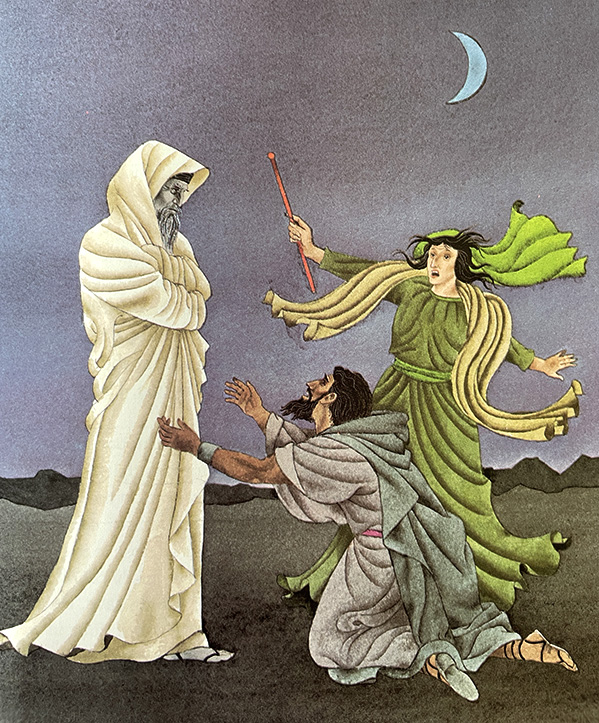Witch of Endor
The Witch of Endor (Hebrew: בַּעֲלַת־אֹוב בְּעֵין דּוֹר) is a woman who, according to the Hebrew Bible, was consulted by Saul to summon the spirit of the prophet Samuel. Saul wished to receive advice on defeating the Philistines in battle, after prior attempts to consult God by throwing lots and other divination means had failed. However, what is summoned, whether the actual ghost of Samuel or a spirit impersonating him, only delivers a prophecy of doom against Saul.
This event occurs in the First Book of Samuel; it is also mentioned in the deuterocanonical Book of Sirach.
Etymology
The woman of the story is called in Biblical Hebrew אֵשֶׁת בַּעֲלַת־אֹוב בְּעֵין דֹּור, "a woman, possessor of an ’ōḇ at 'Endor' (Ein Dor, a location name meaning a circular well or spring). The word אֹ֖וב ’ōḇ has been suggested by Harry A. Hoffner to refer to a ritual pit for summoning the dead from the netherworld, based on parallels in other Near Eastern and Mediterranean cultures. The word has cognates in other regional languages (cf. Sumerian ab, Akkadian âbu, Hittite a-a-bi, Ugaritic ib) and the medium or witch of Endor's ritual has parallels in Babylonian and Hittite magical texts as well as the Odyssey.
Other suggestions for a definition of ’ōḇ include a familiar spirit, a talisman, or a wineskin, in reference to ventriloquism.
In the Greek Septuagint, she is called ἐγγαστρίμυθος ἐν Αενδωρ (engastrímythos en Aendōr), while the Latin Vulgate has pythonem in Aendor, both terms referencing then-contemporary pagan oracles.
The medium says that she sees "elohim arising" (she uses "elohim" in plural, but the apparition becomes singular in Saul's response) from the ground, using the word typically translated as "god(s)" to refer to the spirit of the dead. This is also paralleled by the use of the Akkadian cognate word ilu ("god") in a similar fashion.
Biblical story
When the prophet Samuel dies, he is buried in Ramah (1 Sam 25:1; 28:3). Saul, the king of Israel, seeks advice from Yahweh in choosing a course of action against the assembled forces of the Philistine army. He receives no answer from dreams, prophets, or the Urim and Thummim. Having previously driven out all necromancers and magicians from Israel, Saul searches for a witch anonymously and is told one is living in the village of Endor. Saul disguises himself and crosses through enemy lines to visit her, asking her to raise Samuel. The woman at first refuses, on account of Saul's edict against sorcery, but Saul assures her that she will not be punished.
The woman summons a spirit, and when it appears, she works out who Saul is and screams, "Why have you deceived me? You are Saul!" Saul assures her that no harm will come to her, and asks what she sees. She says that she sees "elohim" rising. Then, Saul asks what "he" looks like, and she describes an old man wrapped in a robe. Saul bows down to the spirit, but is apparently unable to see it himself. The spirit complains of being disturbed, berates Saul for disobeying God, and predicts Saul's downfall. The living Samuel has already said Saul would have his kingship removed, but this spirit adds that Israel's army will be defeated, and Saul and his sons will be "with me" tomorrow. Saul collapses in terror; the woman comforts him, and prepares him a meal of a fatted calf to restore his strength.
The following day, the Israelite army is defeated as prophesied: Saul is wounded by the Philistines, and commits suicide by falling on his sword. In 1 Chronicles, it is stated that Saul's death was, in part, a punishment for seeking advice from a medium rather than from God.
Identity
The Yalkut Shimoni (11th century) identifies the anonymous witch as the mother of Abner. Based upon the witch's claim to have seen something, and Saul having heard a disembodied voice, the Yalkut suggests that necromancers are able to see the spirits of the dead but are unable to hear their speech, while the person for whom the deceased was summoned hears the voice but fails to see anything.
Views by early Christians
The Church Fathers and some modern Christian writers have debated the theological issues raised by this text, which would appear at first sight to affirm that it is possible (though forbidden) for humans to summon the spirits of the dead by ritual magic.
King James, in his philosophical treatise Daemonologie (1597), rejected the theory that the witch was performing an act of ventriloquism, but also denied that she had truly summoned the spirit of Samuel. He wrote that the Devil is permitted at times to take on the likeness of the saints, citing 2 Corinthians 11:14, which says that "Satan can transform himself into an Angel of light." James describes the witch of Endor as "Saul's Pythonese," likening her to the ancient Greek oracle Pythia.
Other medieval glosses to the Bible also suggested that what the witch summoned was not the ghost of Samuel, but a demon taking his shape or an illusion crafted by the witch. Martin Luther, who believed that the dead were unconscious, read that it was "the Devil's ghost," whereas John Calvin read that "it was not the real Samuel, but a spectre." Since this passage states the witch made a loud cry in fear when she saw Samuel's spirit, some interpreters reject the suggestion that the witch was responsible for summoning Samuel's spirit, claiming instead that this was the work of God.
